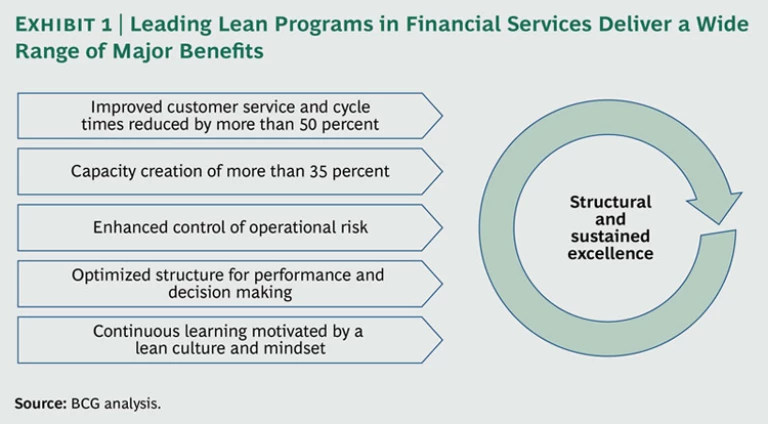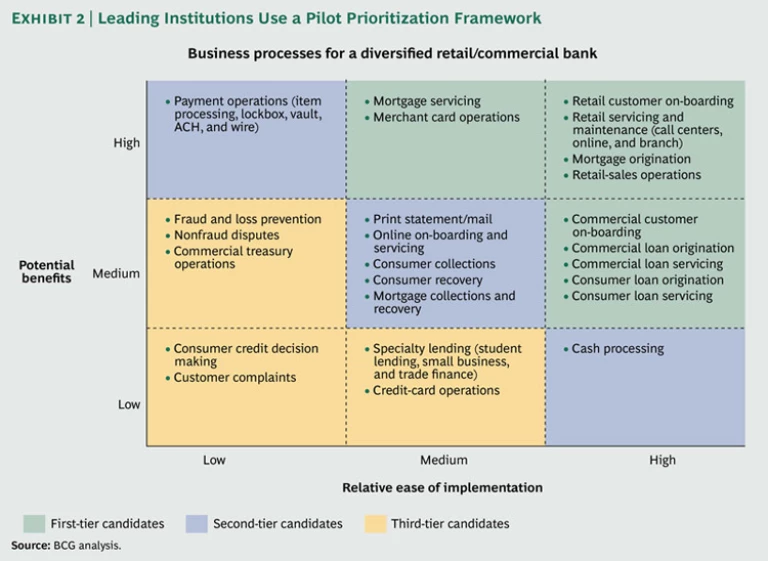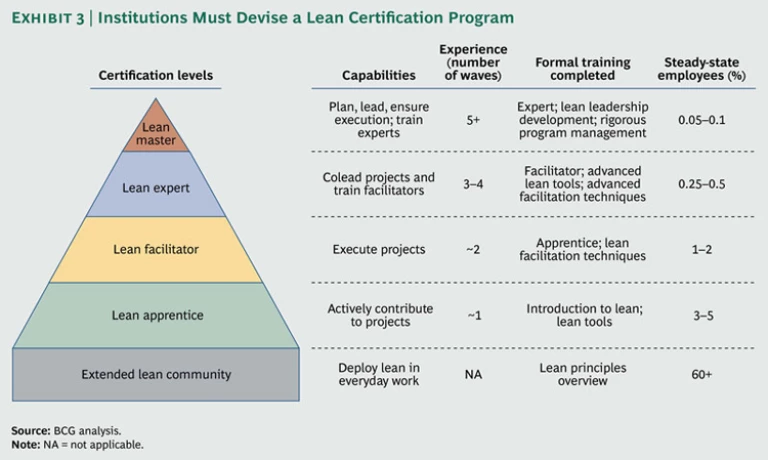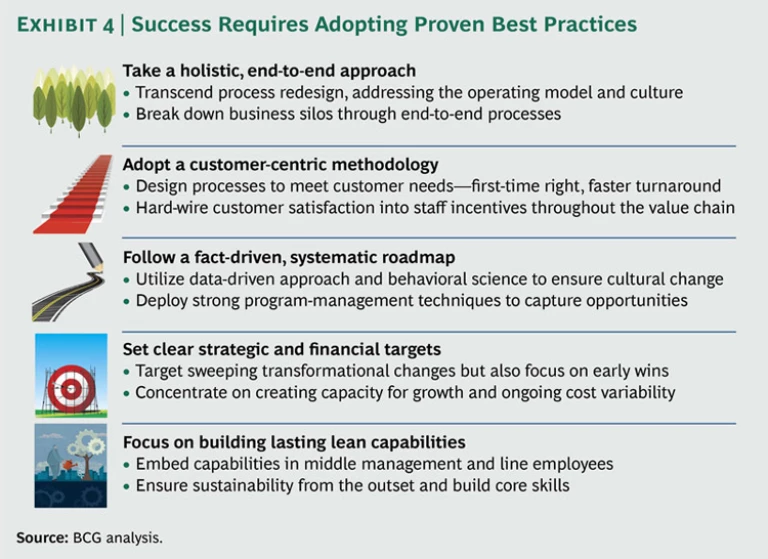Many financial institutions have attempted lean programs of varied scope, but relatively few have achieved the level of success they anticipated. Some institutions have undergone process improvement programs (primarily centered on operations) and have realized limited benefits. Others have carried out comprehensive lean programs and achieved a true step change in some areas but fallen short of embedding the lean mindset in their organizations.
Read more on this topic
Lean That Lasts: The Series
- Capturing the Full Potential
- Embarking on the Journey
- Transforming Financial Institutions
In our view, the most frequent reason for not reaching stated goals is an insufficient understanding of the journey that the organization must take to evolve into a world-class lean institution—a journey that involves driving true cultural change. Successful journeys start with setting up a comprehensive lean program and result in an institution whose DNA is fully infused with lean principles and a lean mindset.
What exactly is “lean”? As we have discussed before, lean is both a methodology and a management philosophy aimed at changing key areas of a financial institution’s operating model. (See Lean That Lasts: Transforming Financial Institutions, BCG Focus, September 2012.) Lean helps redefine processes, structure, functions, and organization. It also improves relationships with partners and end customers. In successful programs, lean becomes part of the institution’s everyday life, with clear benefits in key performance dimensions such as customer experience, capacity creation (greater than 35 percent), and operational risk. (See Exhibit 1.) In our view, the journey toward a truly lean institution consists of four critical steps.
Four Steps to a Truly Lean Organization
Designing a sustainable lean program requires addressing the following core issues up front:
- How to set up the program
- Where to get started
- How to expand the program
- How to make lean sustainable
How to Set Up the Program. Most management teams have only one opportunity to launch a lean program. As a result of our work with numerous clients on lean initiatives, we have found that aspiration, program leadership, and capability development are the crucial differentiating characteristics of successful programs.
- Aspiration defines the goals of the program. Leading financial institutions set aggressive targets for improving customer experience, driving employee engagement, and achieving tangible economic benefits. They charge their lean program with examining the largest and most important end-to-end processes across business and functional lines. In our experience, process opportunities alone can create cost savings and capacity increases of 15 to 25 percent. But the aspiration should go beyond pure process improvements, involving changes to operating-model components such as footprint, organizational design, and IT architecture. The level of aspiration is also the result of a robust business case—one that is strictly adhered to for the duration of the lean program and beyond. Programs without explicitly stated financial and customer-satisfaction goals tend to lose momentum and require strategic reprioritization.
- Program leadership requires a broad vision by the leading executive, who must be able to translate the program aspiration into a roadmap that receives full buy-in throughout the institution. This executive, who is instrumental in sustaining the program’s impetus, must have significant organizational credibility and a track record of leading large-scale change. Best-practice institutions ensure that the appointed leader, who sometimes uses this role as a stepping stone to becoming a senior executive, has active support from the C-suite. It is also critical to establish a well-defined, transparent governance function for the entire lean program to ensure effective and timely execution.
- Capability development involves recruiting a team with functional and business content expertise, financial acumen, and the analytical skills needed to work across business and functional lines. Strong capability development is the only way to secure a sustainable lean program. Ideally, organizations build their teams from within, although many fill selected roles with external hires who are experienced in lean methods and tools. Best-practice institutions extend the core team by training and developing lean experts as projects are completed. These experts support implementation and continuous improvement over time, even after they have rotated back to business line roles where they are often in senior positions. Institutions must recognize employee participation in lean initiatives and make it attractive for high performers.
Where to Get Started. Beginning with two or three pilot projects is an effective way to validate the lean concept internally, build advocacy and commitment, fine-tune methodologies, and demonstrate the potential benefits of the whole initiative—all of which will set the stage and enhance buy-in for subsequent efforts on a broader scale. A key challenge is to set the bar high enough to fuel motivation and build a sense of striving toward a difficult goal—but not so high that the goals can’t be reached, undermining the program before it really gets started.
Moreover, selecting a cross-functional process as one of the pilots establishes the program as a core component of the institution’s strategic agenda, helping drive lean principles throughout the organization and fostering collaboration across business lines and functions. Pilot processes are selected on the basis of criteria such as potential overall impact, level of complexity, and effect on the customer experience. A highly detailed diagnostic of processes is required to build a comprehensive lean roadmap, but leading institutions also utilize initial data and executive workshops to prioritize and rapidly identify “no regret” pilots that have strong business cases. (See Exhibit 2.)
How to Expand the Program. To move from the pilot phase to the full rollout, the institution must decide which processes have high, medium, and low priority and draw a master roadmap that covers the entire organization, taking care not to treat any processes or domains as “sacred cows” that should not be altered or reworked. The announcement of the full rollout should build immediately on the success of the pilots. The institution can maintain momentum by building deeper engagement, involving middle management in the program, and communicating progress and successes to the entire staff.
Key end-to-end processes—large institutions typically have 30 to 60—should be addressed through five to ten waves of lean initiatives. As the institution builds lean capabilities, it should gradually increase the number of processes targeted in each wave, with five to eight addressed simultaneously once the program reaches maturity. For most institutions, the number of processes addressed in each wave will be driven by the level of expertise and lean-focused resources that the institution has been able to build since launching the program.
The development of lean capabilities requires on-the-job training—knowledge gained through the hands-on experience of working on lean initiatives—as well as formal classroom sessions. Some institutions set up internal educational centers focused on lean training, sometimes including a lean certification program that tracks the development of capabilities. (See Exhibit 3.) Further, it is critical that the institution dedicate some of its top talent to the lean program. Incentives should be created to ensure that lean projects are attractive both for managers and rank-and-file employees. It is also crucial to disseminate lean concepts and capabilities throughout the entire organization. Lean experts involved in initial waves should be rotated back into different businesses to apply their knowledge. The goal is to ingrain a lean culture into the institution over time, one that becomes fully integrated into day-to-day problem solving and change initiatives.
How to Make Lean Sustainable. Change management is instrumental in embedding the lean culture into the institution and ensuring long-term sustainability. A strong plan must therefore be put in place. In our experience, the most important change elements are execution certainty, enabled leaders, and an engaged organization.
- Execution certainty ensures that the different elements of the lean program are carried out correctly and efficiently. This certainty comes from having a strong governance structure and strong processes, robust roadmaps, and executive-level tracking and reporting linked to performance management. All of these elements are vital to highlighting potential risks before they materialize and to promoting accountability among initiative owners.
- Enabled leaders are a must because they are active proponents of lean changes within the institution and are accountable for successes and failures. They must have the authority to use their own judgment to solve problems as they arise, the ability to keep the program moving, and the skill to instill their own sense of dedication in other employees. Creating strong leaders requires a crystal-clear definition of accountabilities (one initiative, one owner) and willingness on the part of senior management to celebrate successes and hold team leaders accountable for initiatives that fall behind or fail to deliver. Many successful institutions have launched academies to develop an understanding of lean principles, build the desired management skills, and foster the right behaviors.
- An engaged organization, without which lean programs often fall short of goals, is forged through strong articulation of the case for change by senior management and lean program leaders. Properly structured lean initiatives give a broad base of employees an enhanced and sustained sense of empowerment—a belief that they can focus their energy on fixing problems as they come up and become owners of the solutions. Achieving this level of confidence requires positive reinforcement as well as finely tuned criticism from management. Some behavioral scientists have placed the optimal ratio of positive to negative feedback at four to one, meaning that team motivation is best maintained if there is no more than one negative evaluation of team activities for every four positive evaluations.
The long-term objective should be to make the lean program self-sustaining. Achieving this requires the creation of a vibrant lean community made up of experienced staff from inside and outside the formal program. It also requires the creation of a lean infrastructure that includes a database of lean-trained staff and documentation of lean tools and methods. Lean newsletters, videos, and training opportunities should be available and actively provided to all employees.
Encouraging a vibrant lean community also requires supporting lean behaviors at every level of the organization. By rotating lean-certified staff in and out of the waves, the institution can foster a continuous-improvement mindset within the program and make lean behaviors organic—a routine part of day-to-day operations. Moreover, requiring lean experience for selected leadership positions within the institution creates demand that strengthens the importance of the program and reinforces the lean ethos in the organization.
A Tough but Rewarding Journey
The success of any lean program depends on the individual and collective commitment of senior management and a sizable portion of the entire staff to see the program through. This commitment underpins the journey and is critical to weaving a lean culture into the fabric of the organization.
It is also necessary for the financial institution to have a clear understanding of the lean program’s specific objectives. If goals at the program and specific-project level are not fully transparent, different teams will likely produce inconsistent and conflicting designs that, at best, will create incremental and short-lived improvements and, at worst, will move the institution in the wrong direction. Establishing a shared vision about primary objectives ensures that both program and team leaders design their initiatives to achieve strategic outcomes—which should include an improved customer experience, an ingrained high-performance culture, operational excellence, and, in some cases, all of the above. Well-defined metrics that track progress and milestones must also be put in place.
Finally, any CEO or senior-management team launching or accelerating a lean program should keep the following set of core best practices in mind. (See Exhibit 4.) They are all important, but the first two, in particular, are often overlooked.
- Take a holistic, end-to-end approach.
- Adopt a customer-centric methodology.
- Follow a fact-driven, systematic roadmap.
- Set clear strategic and financial targets.
- Focus on building lasting lean capabilities.
While many financial institutions have realistic goals in mind and do a creditable job of setting the course, many also fail to see the lean journey through to completion. The positive spiral—success that leads to more success—never really gets going. However, by proving the concept with well-executed “showcase” pilots, capturing early momentum to build scale, and embedding the necessary capabilities, lean can become an enduring part of the institution that delivers ongoing and sustainable benefits.
Acknowledgments
The authors would like to thank the following BCG colleagues for their valuable contributions to this publication: Thorsten Brackert, Joseph Carrubba, Andrew D’Anna, Christophe Duthoit, Lubasha Heredia, Yann Letourneux, Andy Maguire, Sushil Malhotra, Hosni Shadid, and Niclas Storz.
The authors would also like to thank Philip Crawford for his editorial direction, as well as other members of the editorial and production team, including Katherine Andrews, Gary Callahan, Sarah Davis, Kim Friedman, and Sara Strassenreiter.









